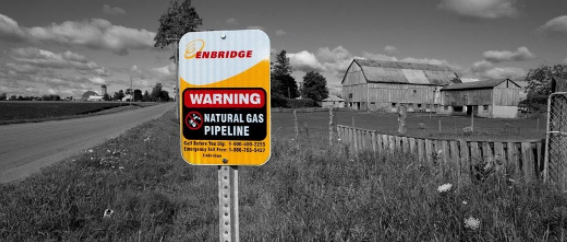Pipelines and You
Print this Article | Send to Colleague
There are over 400,000 km of transmission pipelines in Alberta. It’s staggering when you think about it but when you consider how much Canadians rely on hydrocarbons to not only enjoy our way of life but to survive, and Alberta’s abundance of oil and gas reserves (the third largest on the globe), there’s no safer way to safely transport the massive quantities of these products to refineries and market than by pipeline. As Alberta’s population continues to grow, people and pipelines safely co-exist, providing both abide by rules, regulations and best practices designed to protect communities and the integrity of Alberta’s critical pipeline network.
If you aren’t familiar with how pipelines work and how they are governed, we’ve assembled some helpful information:
The Pipeline Right-of-Way
Pipelines are situated in a right-of-way — a strip of land legally secured by the pipeline company that allows it to construct, operate and maintain the pipeline while the landowner continues to own the land. The width of the right-of-way may vary depending on factors such as pipeline diameter, natural terrain and number of pipelines within the right-of-way. Depending on the pipeline (transmission, distribution or flow line), right-of-way width will vary but will typically range from 12 to 30 m (approximately 40 to 100 ft) for the entire length of the pipeline.
Right-of-Way Agreement
A right-of-way agreement sets out the rights and obligations of both the company and the landowner regarding the use and maintenance of the lands, including restrictions on the use of the land within the right-of-way. Right-of-way agreements are said to "run with the land," which means when land is sold/purchased, the right-of-way agreement is transferred to the new owner.
Activities on the Right-of-Way
Once pipeline construction is completed, landowners and occupants are encouraged to resume using the land where the right-of-way is situated; however, some restrictions now apply. For example, right-of-way agreements typically prohibit installation or construction of any facility over the right-of-way and excavation within 30 m perpendicularly from the centreline of pipe requires written permission from the pipeline company or its governing regulator (either the Alberta Energy Regulator or the Canada Energy Regulator).
Can Pipeline Company Representatives Access My Property?
Yes. Pipeline company representatives have the right to access the pipeline right-of-way for operations and maintenance reasons. As a courtesy, you will typically be contacted by a pipeline company representative in advance to inform you that they will be doing so. In the event of a pipeline-related emergency, however, pipeline company representatives may access the pipeline across your land without notice.
Your Responsibilities When Digging Near a Pipeline
The first step when digging anywhere is to know what’s below and ClickBeforeYouDig. Doing so will identify buried utilities and notify the operators in the vicinity of your project allowing them to either locate and mark their buried energy and utility network, provide an “all-clear” to work or begin a process with you to ensure your project meets regulatory requirements and is carried out safely.
How Deep Is the Pipeline on My Property?
Pipeline depth varies but in general, they are buried approximately 1 m below grade at the time of construction. Over time, however, soil erosion, land levelling and other factors can reduce the depth of cover over a pipeline. Never assume you know the depth — always ClickBeforeYouDig.
How Fast Does the Product in the Pipe Travel?
In general, lighter liquid products, such as gasoline, move at the pace of a fast jog while heavier liquids, such as crude oil, travel through the pipeline at a walking pace. Natural gas can move even more quickly, sometimes at tens of metres per second.
Is it Safe to Have a Pipeline Near My Home?
Yes. Pipelines are the safest method of transporting hydrocarbons across great distances and Canadian legislation and regulations governing pipeline operations are among the most comprehensive in the world. Transmission pipelines are large diameter — measuring up to 48” — and operate at very high pressure, delivering product to major centres and hubs across the continent. Distribution pipelines are significantly smaller, operate at a lower pressure and deliver product to consumers.
How Are Pipelines Monitored?
Pipeline companies employ a variety of methods to monitor the integrity of their pipeline networks such as aerial and ground patrols that monitor the pipeline for construction activities, soil erosion, slope instability and any indication of a leak along the pipeline system (examples: discoloured vegetation or a sheen on a watercourse). Pipelines are also monitored remotely from a pipeline control centre where controllers can close valves to shut-in the pipeline between segments in the event of an emergency. Pipelines are also inspected internally to identify anomalies in the pipe before they become problematic. Click here to see a video of internal pipeline inspection.
How do I Know a Pipeline Is Nearby?
The presence of a pipeline is indicated by signage along the right-of-way promoting the pipeline company name and emergency contact number. These pipeline markers are present at every road, rail, fence and navigable watercourse crossing. If you see a pipeline marker that has been damaged or removed, please call the emergency number indicated on the marker and inform the pipeline company.
 |
If you are digging, always ClickBeforeYouDig to determine the presence of buried pipelines, and any other buried utility, in the vicinity of your digging project.
Mike Sullivan – President, Utility Safety Partners, & Mark Bradley – President, Marram Consulting Ltd.

